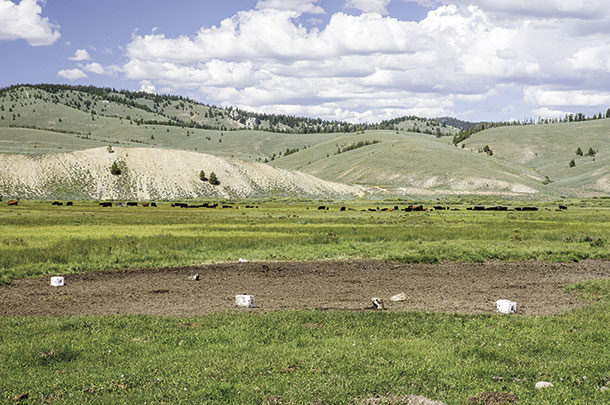Every cattle operation has a mineral program, whether they realize it or not. That may include feeding nothing at all, and the mineral provided to the animal is only what is available through whatever forage and other supplements are provided.
In other cases, they might take an “old-school” approach and put out salt blocks (white), a sulfur block (yellow) and a trace mineral block (red). Yet another option is feeding trace mineralized salt, which is mostly salt with a small amount of trace mineral added.
Complete loose minerals have become used more commonly over the last few decades and are generally considered more “complete” or at least can be formulated as such. Finally, a more recent development is the use of tub supplements as a means of delivering needed minerals.
Obviously, the mineral program comes with a cost.
Some of the basics
- Every cattle operation needs a mineral program. Whether cow-calf, stocker-grower, heifer and bull development, feedlot – all types of operations require a correctly balanced mineral.
- The basics of every program depends on what the foundation nutrient source is. This is generally forage or grain or a combination of the two. Forages, generally, provide a significant portion of minerals required by the animal. Depending on the forage program, the supply can be variable.
- Mineral requirements vary based on the animal type and stage of production.
- Minerals are required for basic physiological functions and for virtually every process of the body. A deficiency of even one will create a decrease in health, reproduction or performance in at least some respect. The problem for many producers is: These deficiencies may not be readily noticeable in the short term. But because it’s not observable or apparent does not mean it is not occurring.
- Excesses of mineral intakes can be as problematic as deficiencies. Feeding multiple sources of minerals (forages, tubs, cubes, loose mineral, liquids) concurrently is expensive plus can create numerous imbalances. It is important to consider the cumulative sources.
- The major components of a loose mineral supplement are the major minerals (calcium, phosphorus, magnesium, potassium, sodium and chlorine), the microminerals (cobalt, copper, iodine, iron, manganese, selenium and zinc) and fat-soluble vitamins (vitamins A, D and E). Other common components are salt and a grain carrier of some type.
- Mineral efficacy depends not only on formulation but also on intake. A mineral is not useful if it is not consumed properly.
What contributes to mineral cost?
As with any feed or supplement, several items affect the cost of a mineral product and how expensive it might be. The two primary items are the nutrient specifications and the ingredients used to meet those specifications.
Nutrient profile
The nutrient profile, which is generally represented by the guarantees on the product tag, illustrates the amount of each nutrient in the product. Depending on your state tagging/labeling requirements and the manufacturer’s desire to share or not share specific amounts, the nutrients represented and the values will vary from product to product and company to company. Some nutrients such as calcium and salt generally fall into a minimum and maximum range. Others are reported as minimum levels.
The nutrient profile for a given product should represent amounts of a given nutrient that will support forages and operations in a given region. This may or may not be the case. In many cases, a mineral product may not be well designed for a given region simply because the selling company has not done sufficient homework to determine what the needs for that region really are; the focus is on cost and not on performance; and mineral nutrition, in general, is still not well understood – in many cases, producers don’t truly know what they need or what to ask for.
In other cases, the nutrient profile may be well designed based on research by the producer, a manufacturing company, extension or academic researchers, local nutritionists, etc. In many situations, this is done on a case-by-case basis. If a producer can use enough product to meet minimum batching requirements by a given company (generally at least 1 to 2 tons), a custom product can be developed based on forage analyses and an audit of other mineral supplies (from other feeds and supplements).
The sources
Once the nutrient profile is established, the sources of these nutrients must be selected. Normally, the major mineral sources are fairly well established. These can include calcium carbonate, mono and/or dicalcium phosphate, potassium chloride, magnesium oxide, salt, etc. There are various options, and the exact source used may vary by manufacturer. The prices they pay for the raw ingredients can vary by the type of material, the screen size (particle size), point of origin (freight), amount used, how good their buyers are, etc. By volume, this makes up the largest portion of the supplement and a significant part of the cost of the supplement.
The trace minerals vary more than the major minerals. There are multiple types commonly used in these formulas. These include the inorganic sources (oxides, sulfates), organics (also referred to as chelates and include amino acid complexes, poly-peptide complexes, glycinates, polysaccharides, etc.) and now the hydroxychlorides. These sources are generally evaluated based on the suggested bioavailability and have probably taken the biggest part of the discussion space over recent history. In general, the common belief is that the more bioavailable a trace mineral source is, the more expensive it will be. This may or may not be true. This is a topic for a whole series of articles. In many cases, manufacturers will use a combination of sources.
Vitamin sources are also fairly common, and there are actually only a few true, base sources for vitamins. This has resulted in significant cost swings over the last few years.
Other ingredients
Other factors affecting the cost of mineral supplements are the large variety of additives that can be included. The sky is almost the limit here, as we can add ionophores, antibiotics (with a Veterinary Feed Directive), yeasts, bacteria, enzymes, B vitamins, feed-through fly controls, plant extracts, flavorings, fats, etc., in endless combinations. The additives can be huge cost contributors to products and should be very carefully evaluated for efficacy and cost effectiveness.
How much is too much for a mineral supplement?
This is the big question. Generally speaking, a good-quality, well-balanced, free-choice mineral supplement will cost in the $20-per- bag range. The price range for retail minerals can run from the low $20s to $50 per bag or more. Based on a typical feeding rate of 4 ounces per head per day, a mineral costing $22 per bag will cost, annually, $40.15. A $50 bag of mineral will cost $91.25 annually.
Again, this is dependent on the nutrient profile, the cost of ingredients (and specific ingredients) to meet the nutrient specifications, the additives included, bagging cost, shipping, company margin, manufacturer, distributor and retail margins. The various layers of margins can also add significant cost to the product and can vary greatly from company to company.
So how much is too much cost for a mineral supplement? This is largely dependent on the end user. The producer has to determine how precise his mineral program needs to be. This starts with forage testing and a look at the other sources of minerals in his overall program and how this meets herd requirements. Once these numbers are gathered, a mineral supplement can be formulated to “fill the gaps” or the search can begin for an off-the-shelf product that matches as closely as possible. Consulting a nutritionist can be helpful.
There are some very expensive products out on the market that list a large number of bells and whistles, some of which are not included in a significant enough amount to be useful (tag-dressing). Some of these are also not well proven and may or may not provide a performance enhancement – but will certainly add to the product cost.
Some products also carry certain “marketing features” that make the product interesting but are of limited usefulness and often overtake what the main focus of the product should be. The producer needs to carefully evaluate the label for specifics of what is a given component, what does it do, is there enough to make a difference, and what does it cost to be there. This can excessively complicate the decision-making process. Remember: It’s about the nutrition.
The main focus for the producer is to provide a mineral supplement that is of high quality and well matched for the herd and overall operation. After that, the other components should be carefully evaluated that each component pays for itself. The first priority is meeting the herd’s needs, then the cost of doing so and then a careful evaluation of what the other cost contributors are. Always focus on getting the most true value for the money.











